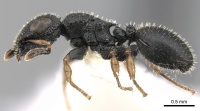Cataulacus difficilis
| Cataulacus difficilis | |
|---|---|

| |
| Scientific classification | |
| Kingdom: | Animalia |
| Phylum: | Arthropoda |
| Class: | Insecta |
| Order: | Hymenoptera |
| Family: | Formicidae |
| Subfamily: | Myrmicinae |
| Tribe: | Crematogastrini |
| Genus: | Cataulacus |
| Species: | C. difficilis |
| Binomial name | |
| Cataulacus difficilis Santschi, 1916 | |
Little is known about the biology of this species. Taylor et al. (2018) report finding on grasses in Benin.
Identification
A member of the tenuis group. Santschi originally associated this species with Cataulacus pygmaeus, but the development of the mesokatepisternal tooth in the type (and only known) worker quickly separates this form. In proportion to the overall size of the individual this tooth is almost as well developed as in the better known species Cataulacus micans, Furthermore, the dimensions and characteristics of the species show it to be more closely related to Cataulacus brevisetosus than to pygmaeus. (Bolton 1974)
Keys including this Species
Distribution
Known from Benin and Cameroon.
Distribution based on Regional Taxon Lists
Afrotropical Region: Benin (type locality), Cameroun.
Distribution based on AntMaps
Distribution based on AntWeb specimens
Check data from AntWeb
Countries Occupied
| Number of countries occupied by this species based on AntWiki Regional Taxon Lists. In general, fewer countries occupied indicates a narrower range, while more countries indicates a more widespread species. |

|
Estimated Abundance
| Relative abundance based on number of AntMaps records per species (this species within the purple bar). Fewer records (to the left) indicates a less abundant/encountered species while more records (to the right) indicates more abundant/encountered species. |

|
Biology
|
Castes
Nomenclature
The following information is derived from Barry Bolton's Online Catalogue of the Ants of the World.
- difficilis. Cataulacus pygmaeus st. difficilis Santschi, 1916b: 506 (w.) BENIN.
- Type-material: holotype worker.
- Type-locality: Benin (“Dahomey”): (no further data) (Desanti).
- Type-depository: NHMB.
- Subspecies of pygmaeus: Wheeler, W.M. 1922a: 916; Emery, 1924d: 297.
- Status as species: Bolton, 1974a: 33 (redescription); Bolton, 1982: 357 (in key); Bolton, 1995b: 138.
- Distribution: Benin.
Unless otherwise noted the text for the remainder of this section is reported from the publication that includes the original description.
Description
Worker
Bolton (1974) - TL 3.3, HL 0.86, HW 0.78, CI 91, EL 0.42, OI 54, IOD 0.58, SL 0.44, SI 56, PW 0.64, AL 0.90, MTL not measurable.
Occipital crest absent; occipital corners each with a pair of small but acute, triangular teeth, one situated at the corner itself, the second just internal to it upon the occipital margin. Sides of head behind the large eyes relatively short but strongly denticulate. Sides of pronotum marginate, strongly denticulate, the remainder of the alitrunk more weakly and sparsely denticulate. Propodeum with a pair of short, acute, divergent spines. Dorsal alitrunk without trace of sutures. Mesokatepisternal tooth strongly developed, triangular, acute and projecting distinctly when the alitrunk is viewed from above. Subpostpetiolar process long and digitiform (subpetiolar process obscured by glue on type). First gastral tergite not marginate laterally.
Dorsum of head finely and shallowly recticulate-rugose, the rugae becoming longitudinal anteriorly. The interspaces of the rugoreticulum sparsely and very shallowly reticulate-punctate, shining, in places the puncturation almost effaced. Pronotal dorsum similarly sculptured but on the mesonotum and propodeal dorsum the cross-meshes are lost, so that the rugae run longitudinally. First gastral tergite strongly and rather coarsely reticulate-punctate, much more strongly so than the head or dorsal alitrunk.
Stout, blunt, erect hairs present upon all dorsal surfaces, simple, relatively long and most abundant upon the head.
Type Material
Bolton (1974) - Holotype worker, DAHOMEY (Desanti) (NM, Basle) [examined].
References
- Bolton, B. 1974a. A revision of the Palaeotropical arboreal ant genus Cataulacus F. Smith (Hymenoptera: Formicidae). Bull. Br. Mus. (Nat. Hist.) Entomol. 30: 1-105.
- Santschi, F. 1916b [1915]. Descriptions de fourmis nouvelles d'Afrique et d'Amérique. Ann. Soc. Entomol. Fr. 84: 497-513 (page 506, worker described)
- Taylor, B., Agoinon, N., Sinzogan, A., Adandonon, A., Kouaguou, Y. N., Bello, S., Wargui, R., Anato, F., Ouagoussounon, I., Houngbo, H., Tchibozo, S., Todjihounde, R., Vayssieres, J.F. 2018. Records of ants (Hymenoptera: Formicidae) from the Republic of Benin, with particular reference to the mango farm ecosystem. Journal of Insect Biodiversity 8(1): 6-29 (doi:10.12976/jib/2018.08.1.2).
References based on Global Ant Biodiversity Informatics
- Bolton B. 1974. A revision of the Palaeotropical arboreal ant genus Cataulacus F. Smith (Hymenoptera: Formicidae). Bulletin of the British Museum (Natural History). Entomology 30: 1-105.
- Santschi F. 1916. Descriptions de fourmis nouvelles d'Afrique et d'Amérique. Annales de la Société Entomologique de France 84: 497-513.
- Taylor B. 1979. Ants of the Nigerian Forest Zone (Hymenoptera: Formicidae). III. Myrmicinae (Cardiocondylini to Meranoplini). Cocoa Research Institute of Nigeria Research Bulletin 6: 1-65.
- Taylor B., N. Agoinon, A. Sinzogan, A. Adandonon, Y. N'Da Kouagou, S. Bello, R. Wargui, F. Anato, I. Ouagoussounon, H. Houngbo, S. Tchibozo, R. Todjhounde, and J. F. Vayssieres. 2018. Records of ants (Hymenoptera: Formicidae) from the Republic of Benin, with particular reference to the mango farm ecosystem. Journal of Insect Biodiversity 8(1): 006–029.
- Tchibozo S., and N. Kaminski. 2006. Note on the social bugs of Benin, West Africa. IUSSI meeting, Washington DC, August 1st 2006.
- Wheeler W. M. 1922. Ants of the American Museum Congo expedition. A contribution to the myrmecology of Africa. VIII. A synonymic list of the ants of the Ethiopian region. Bulletin of the American Museum of Natural History 45: 711-1004

